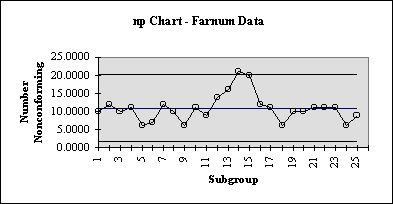
Attribute control charts arise when items are compared with some standard and then are classified as to whether they meet the standard or not. The control chart is used to determine if the rate of nonconforming product is stable and detect when a deviation from stability has occurred. The argument can be made that a LCL should not exist, since rates of nonconforming product outside the LCL is in fact a good thing; we WANT low rates of nonconforming product. However, if we treat these LCL violations as simply another search for an assignable cause, we may learn for the drop in nonconformities rate and be able to permanently improve the process.
The np Chart can be used for the special case when the subgroups are of equal size. Then it is not necessary to convert nonconforming counts into the proportions phat(i). Rather, one can directly plot the counts x(i) versus the subgroup number i.
Steps in Constructing an np Chart
- Determine the size of the subgroups needed. The size, n, has to be sufficiently large to have defects present in the subgroup most of the time. If we have some idea as to what the historical rate of nonconformance, p, is we can use the following formula to estimate the subgroup size:
n=3/p
- Find find pbar.
- Find the UCL and LCL where:
- Plot the centerline pbar, the LCL and UCL, and the process nonconforming
counts, the x(i)’s. - Interpret the control chart. Only if a point is outside the +/- 3 sigma range is the process considered to be out of control.


Example:
Farnum Example: data is from Farnum (1994): Modern Statistical Quality Control and Improvement, p. 245 Sample Day Non-conforming Size 1 10 100 2 12 100 3 10 100 4 11 100 5 6 100 6 7 100 7 12 100 8 10 100 9 6 100 10 11 100 11 9 100 12 14 100 13 16 100 14 21 100 15 20 100 16 12 100 17 11 100 18 6 100 19 10 100 20 10 100 21 11 100 22 11 100 23 11 100 24 6 100 25 9 100 Calculations: PBAR = 0.1088 CL = 10.8800 UCL = n*pbar + 3*sqrt(n*pbar*(1-pbar)) LCL = n*pbar + 3*sqrt(n*pbar*(1-pbar)) Day CL UCL LCL NonConforming 1 10.8800 20.22164354 1.538356462 10.0000 2 10.8800 20.22164354 1.538356462 12.0000 3 10.8800 20.22164354 1.538356462 10.0000 4 10.8800 20.22164354 1.538356462 11.0000 5 10.8800 20.22164354 1.538356462 6.0000 6 10.8800 20.22164354 1.538356462 7.0000 7 10.8800 20.22164354 1.538356462 12.0000 8 10.8800 20.22164354 1.538356462 10.0000 9 10.8800 20.22164354 1.538356462 6.0000 10 10.8800 20.22164354 1.538356462 11.0000 11 10.8800 20.22164354 1.538356462 9.0000 12 10.8800 20.22164354 1.538356462 14.0000 13 10.8800 20.22164354 1.538356462 16.0000 14 10.8800 20.22164354 1.538356462 21.0000 15 10.8800 20.22164354 1.538356462 20.0000 16 10.8800 20.22164354 1.538356462 12.0000 17 10.8800 20.22164354 1.538356462 11.0000 18 10.8800 20.22164354 1.538356462 6.0000 19 10.8800 20.22164354 1.538356462 10.0000 20 10.8800 20.22164354 1.538356462 10.0000 21 10.8800 20.22164354 1.538356462 11.0000 22 10.8800 20.22164354 1.538356462 11.0000 23 10.8800 20.22164354 1.538356462 11.0000 24 10.8800 20.22164354 1.538356462 6.0000 25 10.8800 20.22164354 1.538356462 9.0000
np – Chart:
